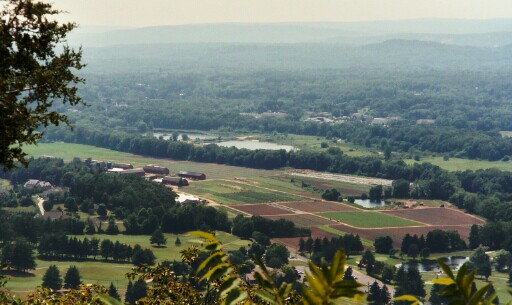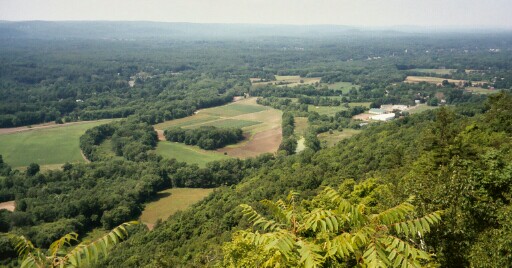August 09, 2003
Views of Farmington River from Talcott Mountain, Near King Phillip's Cave
Connecticut's traprock formations shape the course of tributaries of the ancient river. One is the Farmington River, which winds down from Massachusetts into the bottom lands to the west of the Metacomet Ridge. Part of the ridge is Talcott Mountain, a long, precipitous wooded ledge just west of Hartford.
As if searching for a way east to join the Connecticut, the Farmington flows south through New Hartford as the scenic rapids in "Satan's Kingdom" into Canton , then Collinsville and Farmington, where it turns back north, through Avon and Simsbury, then east to rumble through the Class III rapids of Tariffville Gorge. It finally slides into the Connecticut River in Windsor at the site of the first English settlement in Connecticut, then known as "The Island." The land was originally granted to Joseph Loomis in 1639 and is the present day site of the Loomis Chaffee School just north of Hartford.
We climbed the walking trail along the ridge in Talcott Mountain State Park at the high point of which stands the Heublein Tower, a 165-foot structure built in 1914.
From the trail we enjoyed views of the Farmington River among the tobacco barns and cropland to the southwest, with another traprock range of hills in the far distance:

And views to the northwest, where oxbow ponds lined with rows of trees in the foreground give way to the reforested acres of Simsbury, beyond which lie the Litchfield Hills in the northwest corner of the state and the Berkshires in southwestern Massachusetts.

This was the vista from which, in 1676, the Indian leader "King Philip" is said to have watched as his warriors burned Simsbury to the ground. The large cave in the sheer west face of the mountain is known as King Philip's Cave and the ridge, of which Talcott Mountain is a part, the Metacomet Ridge. The burning of Simsbury was but one incident in the extended conflict between Indian tribes and English colonialists known as "King Philip's War," one of the bloodiest in America's history, ranging from Massachusetts Bay to Rhode Island and Connecticut. But that's another story: King Philip's War: The History and Legacy of America's Forgotten Conflict.
DougSimpson.com/river
Metacomet Ridge, The "Great Wall"
Metacomet Ridge, which shapes the flow of the Connecticut River, has been called The Great Wall. It neatly separated the commerce and transportation of Hartford and New Haven with a wall of igneous "traprock" running from Branford, CT to Northhampton, MA.
In order for New Haven to partipate in the profitable river traffic between Northhampton and the seaports on Long Island Sound, the Farmington Canal was funded and built between New Haven and Northampton during 1825 to 1835. It was plauged with problems from the start, and never proved a financial success. Hartford improved the natural waterway to Northampton with the Enfield Canal built around the shallow water at Windsor in 1829. But the development of the railroads was the final downfall of the Farmington Canal, of which a few ruins still survive along a Heritage Greenway Park.